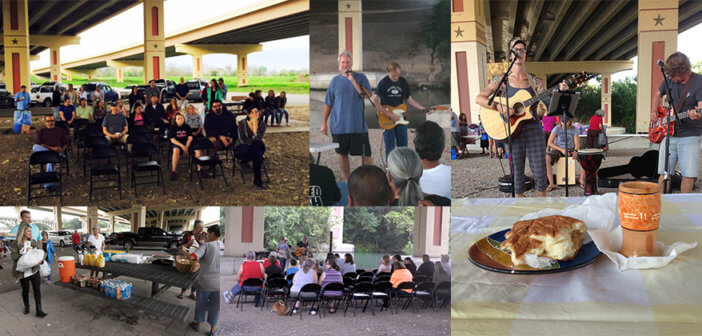Bishop Robert Schnase tells the story of a Texas congregation sharing worship with its homeless neighbors in relational and empowering ways. This powerful example of risk-taking mission began with the simple desire to learn about people’s circumstances and ask, “What do you need?”
Two people, a married couple, actively belonging to a faith community in New Braunfels, Texas, began to experience a particularly strong nudging. It was a question, nagging and persistent: Where do homeless people in our community go each day? Who are they? How do they live, and where do they find shelter? They had seen people who had no homes, but when they asked around they were told that “there are no homeless in New Braunfels.”
The couple kept asking questions and eventually learned why — technically — that was true. Most of the homeless were routinely picked up and taken outside the city limits and left there. The couple persisted, still asking the same questions. Eventually they found small camps located near the interstate, under the bridge of the Guadalupe River, and behind abandoned buildings.
What do you need?
Emboldened by their faith and their spirit of openness, they drove up to the camps, got out of their cars, and gently approached the men and women. In each of these encounters, the couples asked simply, “What do you need?” Socks. Underwear. Food. Batteries. The couple brought those items to the camps and stayed to visit. They listened and shared stories. There were awkward moments and beautiful ones — and laughter. They began to form relationships. Every Saturday they went in search of people their community did not want to see.
Worshiping together
They began to wonder if they might help in other ways. Specifically, they wondered if their friends without homes would like to participate in prayer or worship or even Holy Communion. This idea was welcomed. So, they asked their pastor to come. She did. They worshiped and prayed and shared the sacrament. They gathered again and again. The people in the camps, the couple, the pastor, and a few other everyday disciples from Gruene United Methodist Church decided to make worship under the bridge a regular monthly event. Someone made a promotional flyer, printed copies, and handed them out at the camps and around town.
At 8:45 on Saturday morning, a small team of people from the congregation met at the church to load the trucks with tables and chairs, breakfast and coffee, a generator and music equipment. They carried boxes of clothing, collected earlier in the week as an offering for their homeless neighbors. Folks had also gathered that week to assemble bags of food, enough to last a person for a few days. Those bags were loaded up, too. Someone from the music team created song sheets and made copies so that everybody could participate. Musicians showed up with their instruments. The person from the congregation who had prepared a brief message arrived with notes in hand. The elements for Holy Communion were carefully packed and loaded in the back of a car. These folks who attended the church, others from the community, and people without homes from the various camps all made their way to the designated location, beneath the interstate, along the river’s edge. There they had church. There they were church.
Grace abounds
The next month, on the appointed Saturday, something unexpected happened. The trucks were loaded, song sheets copied, message written, food bags and communion elements all prepared. When the people from outside the homeless community arrived, they were met by a welcoming party made up of their homeless friends who had left the homeless camps early that morning and gathered at the worship site. They swept the dirt to remove cigarette butts, emptied the trash, and made their space ready. They worked elbow-to-elbow with people from the church to unload the truck. They set up tables and chairs. It took off from there. The people who lived in the homeless camp took on the task of welcoming people before worship — they became greeters. They distributed the flyers, inviting people to their church by the river. They enlarged the circle of worshipers, inviting people who slept in their cars and the working poor who simply couldn’t make ends meet.
Many weeks earlier, that couple from the church just knew there were people living without homes in their town, and they decided to serve God by helping them. Those very people were now welcoming them, singing songs of praise, praying and receiving Christ with them, and serving God by helping them as their brothers and sisters in Christ.
This material is excerpted from Five Practices of Fruitful Congregations, Revised and Updated (Abingdon Press, 2018) by Robert Schnase. Used by permission. The book is available at Cokesbury and Amazon.
Related Resources
- “Ministry Beyond the Wall: Revisiting the Five Fruitful Practices,” a Leading Ideas Talks podcast episode featuring Robert Schnase
- Taking Church to the Community Video Tool Kit
- Your Community is Your Congregation by Joe Daniels






